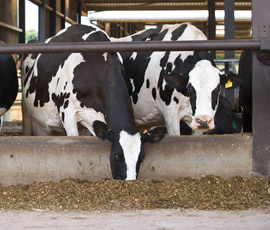Cows being fed copper at alarmingly high rate

Dairy farmers are feeding cows an alarmingly high amount of minerals, new findings from a DairyCo-funded research project show.
Samples of forage, concentrates, water and other supplements, taken on 50 dairy farms in the West Nidlands and north of England, revealed on average all minerals were being fed in excess of recommended rates.
More worrying, many farmers surveyed as part of the study did not know what level of minerals was being fed to cows.
Liam Sinclair, from Harper Adams University who helped carry out the study, explained: “There was a general consensus that if minerals are good, feeding more is better, but there is a cost and unless there’s a benefit to that why would we want to feed more? Indeed, for some minerals such as phosphorus feeding too much can increase the risk of water pollution, and in the case of copper result in cow deaths.”
Copper was being fed in excess two-and-a-half times higher than it should have been.
The recommended level for copper is 11mg/kg of DM, but on average most farms were feeding 28mg/kg DM in early lactation.
Six farms were feeding copper above the legal limit of 40mg/kg of DM in early lactation.
“Ten farms were organic and they were feeding slightly less than average, but most were still well in excess,” said Prof Sinclair.
High levels of copper in the diet can be fatal.
“If you feed too much the liver stores that excess copper until it can’t store any more and it releases it into the bloodstream and the cow can die.”
Most copper deficiencies in the UK are caused by molybdenum and sulphur, which can act as antagonists, locking up available copper.
“But only two farms had high levels of molybdenum and they were feeding some of the lowest levels of copper so there was no rationale for amount of copper being fed in the diet,” added Prof Sinclair.
“Following on from the survey we wanted to investigate the effect of high levels of antagonists versus low levels of antagonists in two types of forage.”
Feeding study
Consequently, a controlled feeding study was carried out at Harper Adams. A group of 56 cows were split in two – half were fed a ration consisting of 75% maize, the other half fed 75% grass silage.
Each diet consisted of 19mg/kg DM of copper and 14 cows from each group were then fed supplementary molybdenum and sulphur at inclusion rates of 1.5mg/kg of DM.
Over a 14-week period milk yield and intakes were monitored daily, while body condition, somatic cell counts and copper levels were also regularly recorded.
Findings showed in the absence of additional sulphur and molybdenum, a diet containing 19mg/kg DM of copper resulted in a net increase in liver copper concentration of 0.75mg/kg DM a day in cows when fed either the grass or maize silage-based ration.
This was lower in diets containing high levels of antagonists.
Cows fed grass silage and high dietary levels of sulphur and molybdenum were most at risk, with somatic cell counts increasing and copper liver levels plummeting rapidly by 0.6mg/kg a day, resulting in an overall decrease over the study period. Dry matter intakes and milk yield also fell by 2.1kg a day and 1kg a day, respectively.
However, those fed maize with higher levels of molybdenum and sulphur were not as badly affected. They noted little change in liver copper levels and SCC remained constant, as did intake and yield.
Take home messages
Prof Sinclair said the results should send a clear message to dairy farmers, especially those feeding grass silage.
“You need to get your diets analysed. If you can’t measure you cannot manage.
“The effect of antagonists is much greater in grass-based rations than in maize rations, so if you are feeding grass silage it is even more important you get a mineral analysis done.”
He added: “One person needs to be responsible for minerals and they need to take into account all the sources of mineral supply.”
Subscribe to receive your free digital edition of Dairy Update direct to your inbox.
